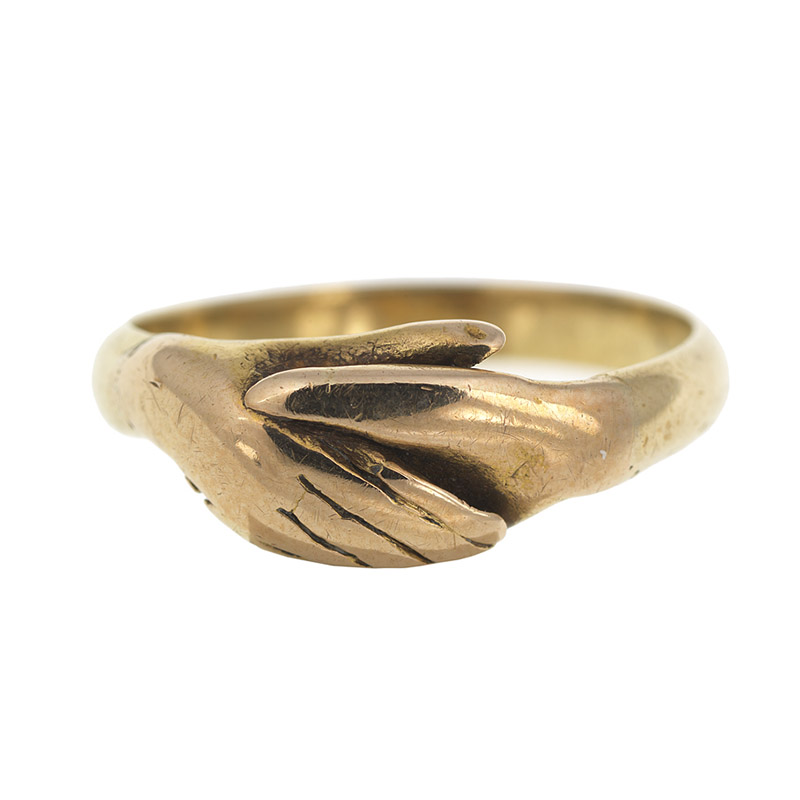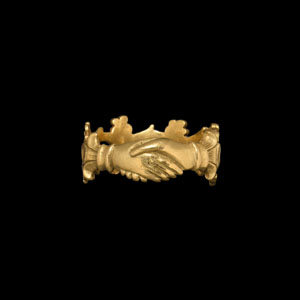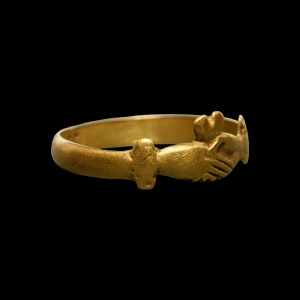Home > Stories by TimeLine Auctions
Stories by TimeLine Auctions
Mani In Fede Rings .. TimeLine’s Tanja Maijala Describes Their Full Circle.
 When the earliest humans first held pointed sticks and turned their bodies through three hundred and sixty degrees, they drew rings on the ground that soon took on magical significance. Men and women saw the endless circle as a symbol of eternity. A few thousand years later Bronze Age artisans cast metal circles of copper. Believers in their powers wore them to ward off misfortune. Today we see evidence of their faith in ancient circles whenever a Bronze Age metal bangle or ring comes under the hammer at a TimeLine Auction.
When the earliest humans first held pointed sticks and turned their bodies through three hundred and sixty degrees, they drew rings on the ground that soon took on magical significance. Men and women saw the endless circle as a symbol of eternity. A few thousand years later Bronze Age artisans cast metal circles of copper. Believers in their powers wore them to ward off misfortune. Today we see evidence of their faith in ancient circles whenever a Bronze Age metal bangle or ring comes under the hammer at a TimeLine Auction.
Ancient Egyptians and Greeks appreciated the circle’s symbolic importance; but only the Egyptians seem to have used rings widely in marriage ceremonies. The shape, having neither beginning nor end, signified eternity; while the hole it surrounded captivated Egyptian minds with the idea of an entrance to the afterlife, or into the circular sun and moon. Finger rings in the shape of a serpent swallowing its tail symbolized the cycle of life. The Greek name for a serpent ring was ouroboros (tail devourer).
 Fascination with anatomy persuaded Egyptian physicians that the human heart carried lifeblood to the left hand’s fourth finger, which took on the role of the ring finger. That convention is followed in many, though not all, countries down to the present-day.
Fascination with anatomy persuaded Egyptian physicians that the human heart carried lifeblood to the left hand’s fourth finger, which took on the role of the ring finger. That convention is followed in many, though not all, countries down to the present-day.
In Roman Republican times, a law that restricted the wearing of gold jewellery to patrician families obliged plebians to make engagement rings from alternative metals. They chose iron. A further prohibition banned plebian use of intaglio designs. Instead, iron engagement rings had incised decoration, with a clasped hands image proving most popular. Known as annulus pronubus, engagement rings received a boost in popularity when, in Early Christian Roman times, prohibitions against gold jewellery relaxed. Rings made from pure gold, with bezels formed as two firmly clasped right hands, now announced engagements to marry far-and-wide across the Empire.
Since the earliest human conflicts using hand-held weapons, the universal sign for a warrior brandishing no weapon took the form of an open right hand held out to indicate unarmed. A reciprocal right hand held out to grasp the offered hand indicated truce. The implications of those early right-hand grasps broadened to embrace alliance, good faith, loyalty, and closeness. From there the symbolism spread to betrothal rings where clasped hands declared love, and faithful promises of marriage. The rings became known as dextrarum iunctio (joined rights); and their use continued after the fall of the Roman Empire into the Early and Later Middle Ages.
The dawning of the Renaissance during the 12th – 14th centuries led to Italy’s rediscovery of forgotten Roman arts, included new and more elaborately decorated engagement rings, renamed in Italian mane in fede rings (The phrase translates as hands clasped in faith). One of the elaborations introduced the gemmel or gimmel ring, named from the Latin word gemellus, meaning twin. It consisted of two separate hoops, each with a hand-shaped bezel. When brought together, the hands locked to form a single mani in fede ring. At some wedding ceremonies the bride and groom, each wearing one of the gemmel hoops, brough them together to form the wedding ring, which was then placed on the bride’s ring finger.
Fede rings inscribed with religious and romantic phrases in Latin or Norman French; together with symbolic representations of romantic love, such as doves and flowers; also made their appearance in Renaissance times. Known as posy, posie or poesy rings – all variations on the word poetry – they initially carried their messages on the exteriors of ring hoops. Later versions moved the messages and symbols to inner surfaces of hoops on which lovers could exchange hidden words and images.
 Two unusual developments in fede rings occurred later in the British Isles. In England the 17th century Restoration of Charles II and his marriage to Catherine of Braganza encouraged the making and wearing of fede rings with hoops in the form of floral wreaths; and with the hands surmounted by a crown. In Ireland; specifically in Claddagh, a suburb of the city of Galway; local jewellers popularized the wearing of fede rings on which the hands hold a heart with a crown placed above it. Symbolically the hands represent faithfulness; the heart indicates love; and the crown declares loyalty.
Two unusual developments in fede rings occurred later in the British Isles. In England the 17th century Restoration of Charles II and his marriage to Catherine of Braganza encouraged the making and wearing of fede rings with hoops in the form of floral wreaths; and with the hands surmounted by a crown. In Ireland; specifically in Claddagh, a suburb of the city of Galway; local jewellers popularized the wearing of fede rings on which the hands hold a heart with a crown placed above it. Symbolically the hands represent faithfulness; the heart indicates love; and the crown declares loyalty.
Footnote:
A description of the ring given to Lady Hamilton by Lord Nelson; and now in the Maritime Museum at Greenwich, reads:
Gold fede or betrothal ring; one of a pair exchanged by Vice-Admiral Horatio Nelson, and Emma, Lady Hamilton. Nelson wore his at Trafalgar. It is now on display at the National Maritime Museum, Greenwich. Lady Hamilton’s ring can be seen at the Royal Naval Museum, Portsmouth. It is believed the lovers took communion together before Horatio sailed for Trafalgar. They probably exchanged rings at that time.
As well as handling sales of many fede rings at TimeLine Auctions, our CEO, Brett Hammond and his family, have a closer connection than most with the famous romantic pair mentioned above. The Hammonds have lived for more than a decade at The Three Cups, Church Street, Harwich; formerly the inn at which Horatio and Emma spent time before Nelson set sail on his final voyage to immortality. St Nicholas Church, where they probably took communion and exchanged their fede rings, stands adjacent to The Three Cups. Thus, a story of mani in fede rings comes full circle.
Tanja Maijala, TimeLine Auctions, 18th January 2024




